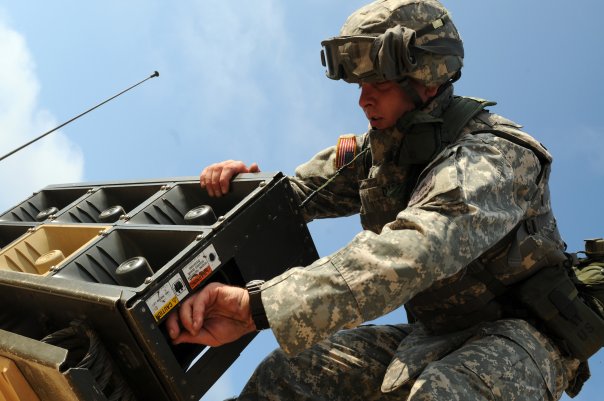The opening scene of The Forever War by Dexter Filkins presents us with the sight of U.S. soldiers preparing for their invasion of Falluja. Filkins is there to witness the attack; amidst the growl of tanks and Humvees, and “by the light of airstrikes and rockets,” he writes, there is suddenly something sonically unexpected.

[Image: “An Advanced Individual Training Soldier in the Psychological Operations Specialist Course attaches a loud speaker on top of a High Mobility Multi-Wheeled Vehicle, or HUMVEE, at Forward Operating Base Freedom, Camp MacKall, N.C.” Courtesy of the John F. Kennedy Special Warfare Center and School].
“And then, as if from the depths,” Filkins writes, “came a new sound: violent, menacing and dire.”
I looked back over my shoulder to where we had come from, into the vacant field at Falluja’s northern edge. A group of marines were standing at the foot of a gigantic loudspeaker, the kind used at rock concerts.
It was AC/DC, the Australian heavy metal band, pouring out its unbridled sounds. I recognized the song immediately: “Hells Bells,” the band’s celebration of satanic power, had come to us on the battlefield.
While by no means advocating the use of sonic warfare as a tool in U.S. military adventures or police operations, I nonetheless instantly thought of this scene—of armed soldiers holding aloft rock-blaring boom boxes, like some John Milius-directed remake of Say Anything—when I read, in a very different context, that bark beetles can be driven out of the pine forests they currently infest if you play digitally-altered sounds of their own chewing back at them through loud speakers. The high-volume sound of themselves drives them away.
A research assistant suggested using sounds to aggravate the beetles, much as police sometimes blare music in hostage situations. The researchers tried Queen and Guns N’ Roses and played snippets of radio talker Rush Limbaugh backward. None produced the desired results.
Then, the beetles were exposed to digitally altered recordings of their own calls, the sounds they make to attract or repel other beetles. The response was immediate. The beetles stopped mating or burrowing. Some fled, helter-skelter. Some violently attacked each other.
Most important, they stopped chewing away at the pine tree, suggesting that the scientists may have discovered a sort of sonic bullet that could help slow the beetles’ destructive march.
Again, I do not mean to imply that infestation metaphors are the most appropriate to use when discussing Operation Phantom Fury, or that military action in that city was analogous to clearing a forest of bark beetles; but the audio possibilities here, and the specifics of the set-up, seem amazing.

[Image: A ponderosa pine forest; within those trunks might be beetles].
More about the actual experiment, run at Northern Arizona University’s Forestry Lab:
They collected tree trunks infested with bark beetles… Working in the lab, [research assistant Reagan McGuire] piped in the music through tiny speakers, the sort you might find in a singing greeting card. He watched the reaction of the beetles using a microscope. The rock music didn’t seem to annoy the bugs, nor did Rush in reverse.
McGuire and [Northern Arizona University forest entomologist Richard Hofstetter] decided to try something different. They recorded the sounds of the beetles and played them back, manipulating them to test the response.
Suddenly, every little thing they did seemed to provoke the beetles.
“We could use a particular aggression call that would make the beetles move away from the sound as if they were avoiding another beetle,” Hofstetter said.
When they made the beetle sounds louder and stronger than a typical male mating call, he said, the female beetle rejected the male and moved toward the electronic sound.
These audio simulations, in other words, had demonstrable physical effects on another species; their own warped sonic portrait drove them crazy.
So could you reprogram your Marsona 1288A (“create a personalized sound environment“) with the digitally-altered ambient sounds of termites and thus clear your house of insectile pests? The USDA, after all, has published a paper—download the PDF—explaining how a “portable, low-frequency acoustic system was used to detect termite infestations in urban trees.” Indeed, “termite sounds could be detected easily underneath infested trees, despite the presence of high urban background noise.” So why not reverse this—drive them out of the city using weird MP3s specially produced for boom cars?
Perhaps we should petition Clear Channel or Sirius XM to premiere a new, insect-only broadcast hour, killing ants and roaches in every city where it’s played (or perhaps just driving them all out, streaming from the floorboards, in a moment of utter horror).
I’m reminded here of the famous example of Sgt. Pepper’s Lonely Hearts Club Band by The Beatles, with its “dog whistle—which humans can’t hear—buried on the album’s second side.” Only, in our case, it would be a different kind of beetle-whistle, and one with anti-infestational effects.
(Bark beetle story found via @treestrategist).